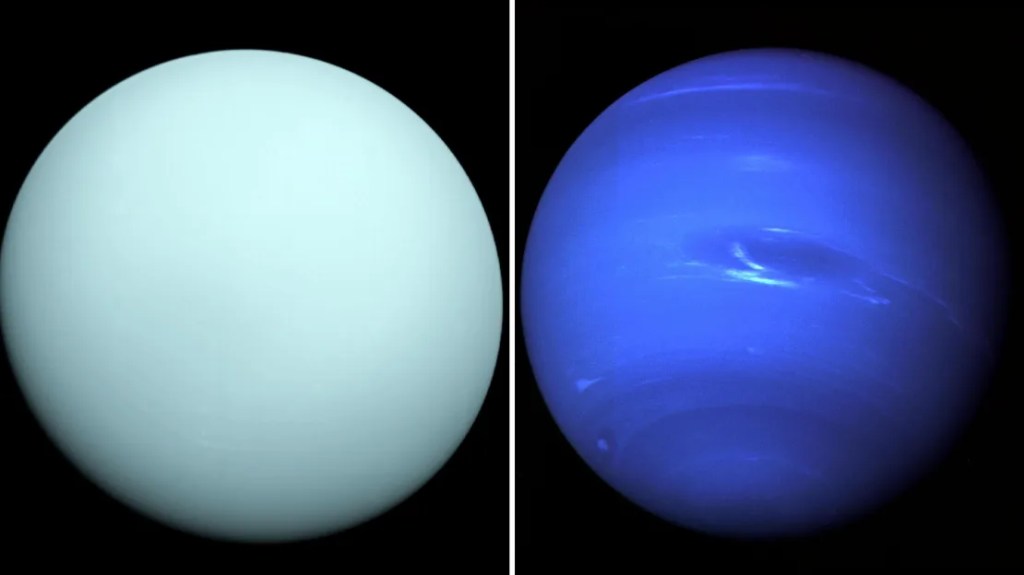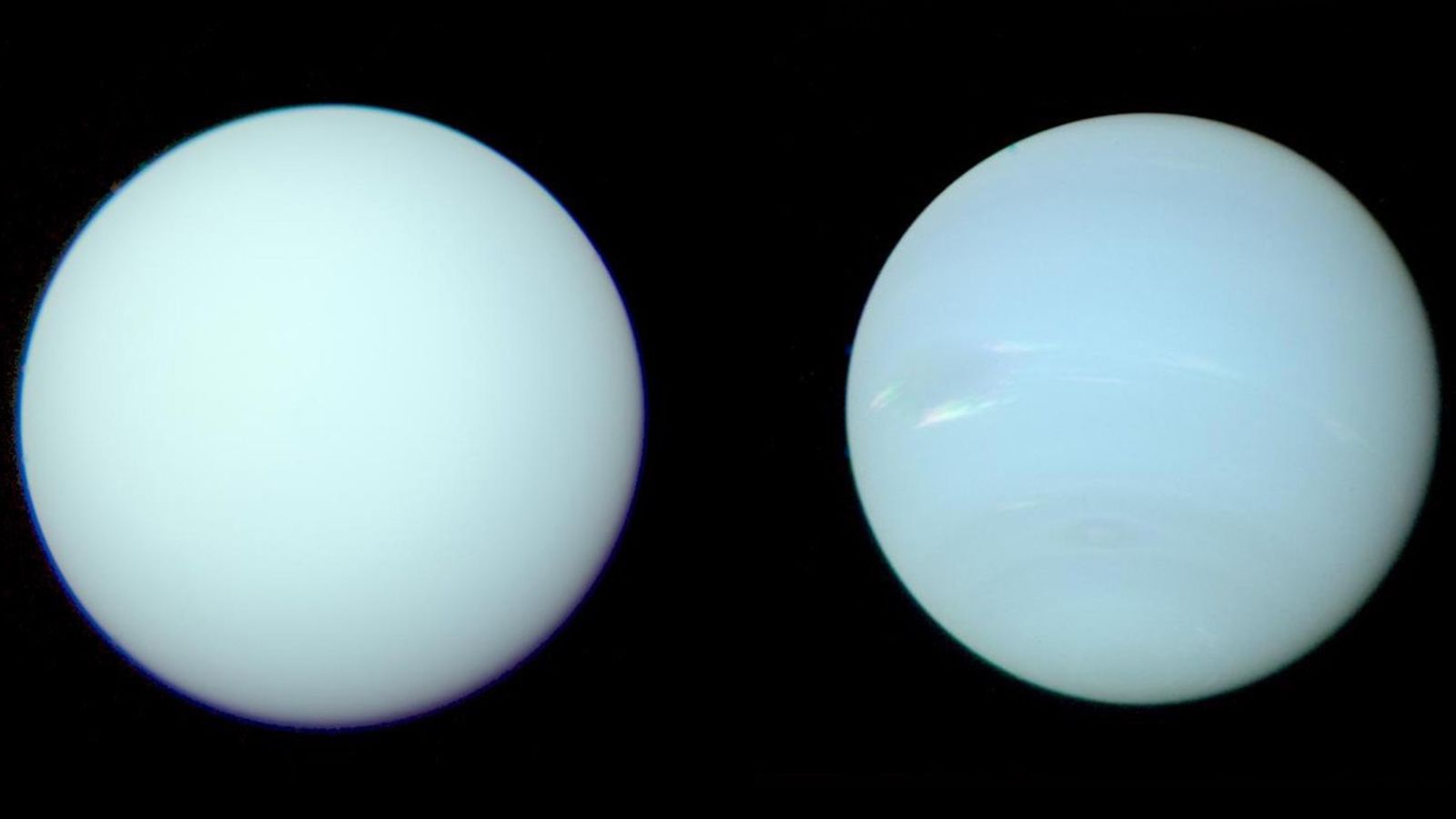(CNN) — New research has found that the true colors of Neptune and Uranus, which often appear in images with noticeably different colors, may be more similar than previously thought.
The first detailed views of the ice giants at the outer edge of our solar system were made possible by NASA's Voyager 2 mission, which made flybys of Uranus in 1986 and Neptune in 1989. Voyager 2 remains the only spacecraft to fly by both planets. Worlds.
Uranus appeared a pale cyan color, while Neptune was depicted in a stunning dark blue. Voyager 2 took images of each planet in separate colors, and the monochrome images were combined to create composites. Images of Neptune have been enhanced to show the white clouds and winds of the planet's atmosphere.
“Although known images of Uranus taken by Voyager 2 were published in a form closer to 'true' color, the images of Neptune were actually stretched and enhanced, and thus artificially blue-shifted,” Patrick said. Professor of Planetary Physics at Oxford University and author of a new study on the images, said in a statement.
“Although the artificially saturated color was known to planetary scientists at the time, and images were published with captions explaining it, this distinction has been lost over time.”
The Hubble Space Telescope's Spectrograph Imager and the Very Large Telescope's Multi-Unit Spectrograph Explorer capture a continuous spectrum of colors, resulting in greater color accuracy. Irwin and his team applied the data collected using those instruments to the original Voyager 2 images.

Voyager 2 took the first detailed images of Uranus in 1986 (left) and Neptune in 1989.
Corrected images show that Neptune and Uranus have a similar blue-green hue. Both planets have atmospheric haze, but Neptune appears slightly bluer because it has a thinner layer of haze.
“By applying our model to the original data, we were able to reconstruct the most accurate representation to date of the color of Neptune and Uranus,” Irwin said.
The team's findings and new image, published Thursday in the Monthly Notices of the Royal Astronomical Society, not only address a long-standing question about ice giants, but pave the way for a better understanding of the mysterious planets, researchers say.
The changing colors of Uranus
While solving one planetary mystery, the research team took the opportunity to answer another: Why does Uranus appear to change color as it orbits the Sun, as in the image below?

A year on Uranus lasts 84 Earth years. While the planet appears greenest during the summer and winter solstices, it is bluest during the equinoxes.
This unusual world rotates on its side, so that one of the planet's poles points toward the Earth and the sun during solstices.
When comparing images of Uranus for the study, researchers looked at measurements of the planet's brightness recorded by Lowell Observatory in Arizona between 1950 and 2016.
The team developed a model that compared light data from the polar regions with that from the tropics, and found that the polar regions reflect more green and red light wavelengths. This model involves adding a “veil” of gradually thickening fog made of methane ice, which was observed as the planet transitioned from equinox to solstice.
“In this way, we showed that Uranus is greener at the solstice because the polar regions have a lower abundance of methane but also a greater thickness of brightly scattered methane ice particles,” Irwin said.
Dr. Heidi Hamel, the Association of Universities' vice president of science for research in astronomy, has spent decades studying ice giants.
“Misunderstandings of the color of Neptune, as well as unusual changes in the color of Uranus, have plagued us for decades,” Hamel, who was not involved in the study, said in a statement. “This comprehensive study should finally put both issues to rest.”
Investigating ice giants
There are still many mysteries about ice giants. The James Webb Space Telescope recently unveiled a new image of Uranus that shows its often invisible rings and hidden features of its atmosphere.
In recent years, researchers have detected X-rays coming from Uranus. Scientists also found a strange “blip” in the Voyager 2 data indicating that the spacecraft flew through a plasmoid, a giant magnetic bubble that likely tore off part of the planet's atmosphere and floated off into space.
“The mission to explore the Uranian system – from its strange seasonal atmosphere to its diverse collection of rings and moons – represents a top priority for space agencies in the coming decades,” said study co-author Lee Fletcher, a planetary scientist at the university. Leicester City in a statement.
“Ground-based studies like this, which show how Uranus’s appearance and color have changed over the decades in response to the solar system’s strangest seasons, will be vital for putting this mission’s future discoveries into their broader context.”

“Proud web fanatic. Subtly charming twitter geek. Reader. Internet trailblazer. Music buff.”


:quality(85)/cloudfront-us-east-1.images.arcpublishing.com/infobae/7TXNTX4Z6ZADNGBBYTUT45QETM.jpg)
:quality(85)/cloudfront-us-east-1.images.arcpublishing.com/infobae/TR43PX4FQRCGJOYTK6DVVHHXGE.jpg)


More Stories
NASA finds rock on Mars that may contain ancient microscopic life
Astronauts stranded in space due to Boeing spacecraft malfunction won’t be able to return home for weeks
Download YoWhatsApp Plus 2024 Latest Updated APK for Android | WhatsApp Plus APK